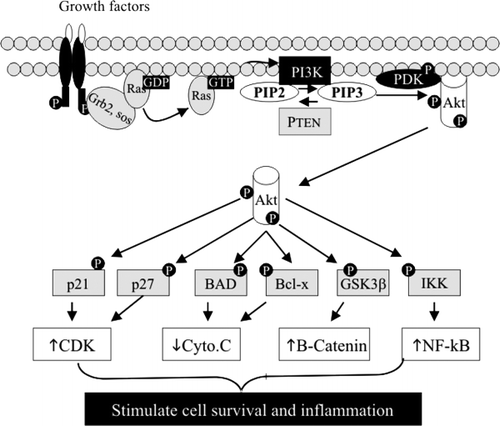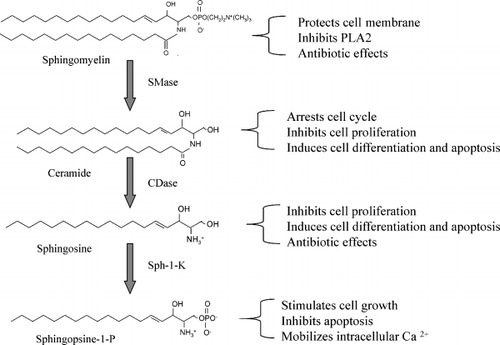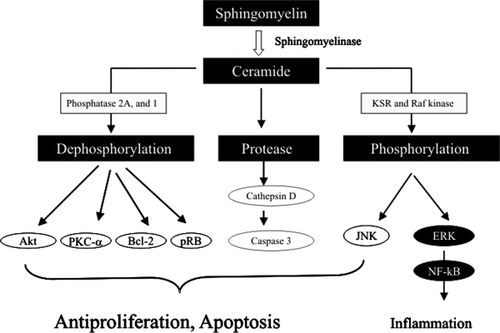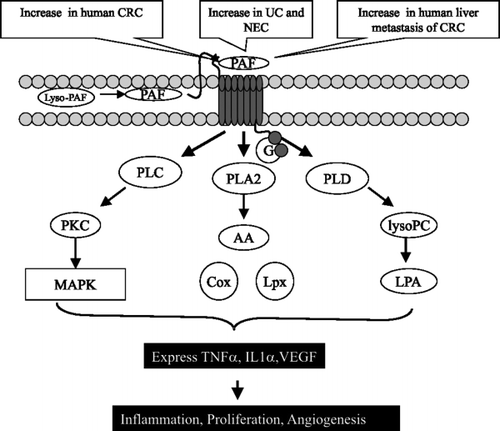Figures & data
Fig. 1. Phosphatidylinositol 3-phosphate kinase (PI3K)–protein kinase B (Akt) pathway. The pathway is triggered by many growth factors, which induce activation of PI3K and Akt. By phosphorylation of targeting proteins, Akt stimulates cell proliferation and inflammation and inhibits apoptosis. BAD: Bcl-associated death promoter; CDK: ceramide dependent kinase; cyto.C: cytochrome C; GDP: guanosine diphosphate; Grb: growth factor receptor bound protein; GSK: glycogen synthase kinase; GTP: guanosine triphosphate; IKK: inhibitor of κB kinase; PDK: PIP3 dependent kinase; PIP2: phosphatidylinositol 4,5-bisphosphate; PIP3: phosphatidylinositol 3,4,5-triphosphate; NF-κB: nuclear factor-κB; PTEN: phosphatase and tensin homologue deleted on chromosome 10; SOS: son of sevenless.

Fig. 2. Phosphatidylcholine (PC)–phospholipase A2 (PLA2) pathway. PC is hydrolysed by PLA2 to generate arachidonic acid, which can be converted to prostaglandins and leukotrienes by cyclooxygenase-2 (Cox2) and 5-lipoxygenase (5-Lpx), respectively, leading to cell proliferation and inflammation. G: G protein; LPC: lysophosphatidylcholine; MAPK: mitogen-activated protein kinase; PG: prostaglandin; SMase: sphingomyelinase; TX: thromboxane.

Fig. 3. Hydrolysis of sphingomyelin (SM) and the biological effects of the metabolites. The hydrolytic process of SM and the enzymes involved are shown on the left and the biological effects of the metabolites on the right. CDase: ceramidase; PLA2: phospholipase A2; SMase: sphingomyelinase; Sph: sphingopsine.

Fig. 4. Signal pathway affected by ceramide. Ceramide induces dephosphorylation of many proliferative and antiapoptotic molecules, activation of cathepsin D, and activation of c-Jun N-terminal kinase (JNK) and extracellular signal-regulated kinase (ERK). The main outcome by ceramide is the inhibition of cell proliferation and stimulation of apoptosis. Akt: protein kinase B; KSR: kinase suppressor of Ras; NF-κB: nuclear factor-κB; PKC: protein kinase C.

Fig. 5. Signal transduction pathways affected by platelet activating factor (PAF). PAF binds G-protein-coupled receptors and activates several types of phospholipase (PL), resulting in inflammation, proliferation and angiogenesis. Cox: cyclooxygenase; CRC: ??; IL: interleukin; LPA: lysophosphatidic acid; Lpx: lipoxygenases; lysopC: ??; MAPK: mitogen-activated protein kinase; NEC: ??; PKC: protein kinase C; TNF: tumour necrosis factor; UC: ??; VEGF: vascular endothelial growth factor.
